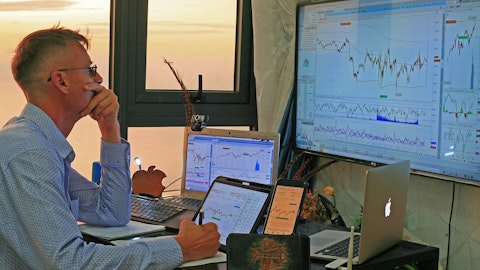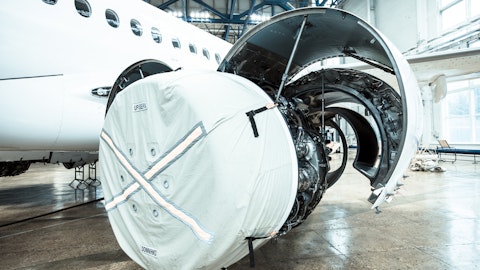Shawn Mural: Yes. Hey, Joe, this is Shawn. Yes, so exactly as you pointed out, right. So the pending awards increased $3 billion in the quarter. It’s a bit muted environment relative to the case and the cadence of the awards, and nothing of note. I don’t think we’re concerned about anything, but we are seeing a bit of a slowdown from some of those things. We would have liked to have seen them, but I — it doesn’t change our outlook for successfully capturing those — that work. Chuck, anything else?
Chuck Prow: No. I think, you’re right. We — as always, in continuing resolution, the rate and pace of awards slow. Again, the ops tempo that we’re seeing, and you see that in our revenue and our on-contract growth continues strong. So, I think, as we move through this year, we will see awards again. It will be a little slower than we would like, but we’re very confident in our guidance.
Joe Gomes: Okay. And speaking of the guidance, the adjusted EBITDA margin, if I look at it on the midpoint, it’s — it comes to be about 7.4% in 2024, which would be flat with 2023. And is that just a kind of reflection of more of some of these newer contracts just beginning, or is there anything else behind that fact that it appears to be flat projected year-over-year?
Shawn Mural: Yes. No. Joe, I’d say it’s exactly as you described, right. So, some of the programs that are completion, right. So, we’ve set all along our programs, as they mature, they tend to move into higher margins. We’re seeing the ramp up of new work. We’ll continue to mature those things and improve the profitability over time. And so, throughout the year, you’ll see us do that kind of sequentially when we think about the margin profile of the business over the course of the year. But, yes, you’re exactly right at the midpoint. We’re probably right at the 7.4% there, yes.
Joe Gomes: Okay. One more for me on the guidance, and maybe you can kind of give us a little bit of cadence. Historically, you’re kind of at that 45% in the first-half, 55% revenue in the second-half. But one of the things Chuck you had mentioned, last year you benefited in the first and second quarter by the exercises in INDOPACOM. I’m assuming those don’t repeat this year. Maybe you can give us a little bit of size, the impact they had on Q1 and Q2? And should we still kind of expect that 45%, 55% split on the guidance?
Shawn Mural: Yes. I’d say — I’d look at it this way on the top line, Joe. I’d look at slightly less than 50% probably of the revenue in the first-half. Somewhere right between that 45% and 50% in the first half of the year. And then on the margin profile and the adjusted EBITDA, I’d probably look at that as being slightly below kind of 45% in the first half. Again, consistent with that ramp that we’ll see sequentially, kind of, quarter-by-quarter as we go throughout the year as new work comes on and as the teams mature our execution. Chuck, anything else?
Chuck Prow: No. As you said it perfectly, last year we did benefit from kind of extraordinary activity that happened in the beginning of the year. As you know, you followed us for a while. The first half, second half dynamic has been very consistent, going all the way back to Vectrus days. And, again, we feel very comfortable with the guide and we feel very comfortable with the ramp throughout the year.
Joe Gomes: Great. Thanks for taking my questions.
Chuck Prow: Thank you. Appreciate it.
Shawn Mural: Thank you.
Operator: Our next question comes from Trevor Walsh with Citizens [JMP] (ph). Please proceed with your question.
Trevor Walsh: Hi. Great morning, team. Thanks for taking my questions, and I’ll echo my congrats on a great finish to the year. Similar to the color that you provided on the FMS pipeline, I was wondering, Chuck, maybe if you could do a similar type of rundown just on the $9 billion in bids submitted that you had. Just kind of — just generally where that falls within the portfolio of products and how that looks in terms of what the mix is there, if you could?
Chuck Prow: Yes. No. That’s — thank you for asking the question, because we’re really thrilled with how we’ve been able to kind of curate or cultivate our pipeline over the last couple of years. Of that $9 billion, I would say there’s a good mix, maybe you call it a proportional mix between our core businesses of logistics based management and aerospace O&M, and then the newer converged technology and engineered solution pipeline. We really have a really nice emerging pipeline in our intelligence community business as well. So, again, the new capabilities that we have introduced over the last several years are now importantly represented in that pipeline that we discussed, and we’re actually thrilled with that progress.
Trevor Walsh: Great. Terrific. You mentioned a newer defense system or platform. I don’t know if that’s classified or if you’re able to give it a little bit more detail or it’s just not finalized yet, but just curious how technology driven that particular project was?
Chuck Prow: Yes. It’s — we can’t talk — we cannot talk about it. It is finished. It’s a wonderful story. It’s something — it’s a requirement that went from inception to fielding in under a year, and it’s highly technical. Again, falling back to the engineered solutions that we discussed here during the call and in the prior questions, you can simplify it this way or generalize it this way, is we are taking existing platforms, some of them older, some of them more recent, and we are engineering ways for those older platforms to either work together and/or to extend their capabilities. It’s a really important part of our business, because we can now approach both the military intelligence communities as well as prime contractors with new and different ways of, again, extending lifecycles and/or improving capabilities of — in many cases, platforms that have been out there for a long, long time.



